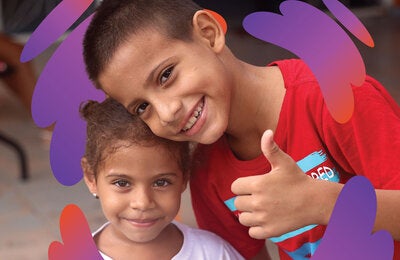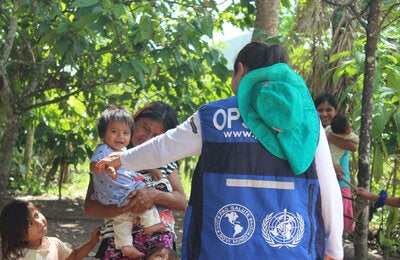
Tens of thousands more doctors and nurses expected to be needed to manage ICUs in Latin America and the Caribbean. PAHO helps countries deploy medical teams and scale up oxygen production; donates vital supplies.
Washington, D.C., May 12, 2021 (PAHO) – As shortages of health workers loom and oxygen supplies run “dangerously low,” the Pan American Health Organization (PAHO) is intensifying donations and technical assistance to countries in Latin America and the Caribbean, PAHO Director Carissa F. Etienne said today.
Amid the COVID-19 pandemic, “the rise in hospitalizations across our region is triggering an unprecedented oxygen supply challenge,” Dr. Etienne said at her weekly media briefing. In response, PAHO is helping countries scale up oxygen production and donating vital supplies, including 7,000 pulse oximeters and nearly 2,000 oxygen compressors.
“We’re working hand-in-hand with ministries of health, particularly in hard hit places like Bolivia and Antigua and Barbuda to help countries redesign their models of care and update their clinical guidelines to optimize resources available and ensure that more patients receive the oxygen they need,” Dr. Etienne said.
Meanwhile, PAHO has helped deploy 26 emergency medical teams in 23 countries. “In addition, some 400 Emergency Medical Team and alternative medical care sites have been established, helping countries expand capacity with 14,000 new hospital beds and 1,500 more intensive care beds,” she added.
But considering the current spread of the disease, an additional 20,000 doctors and more than 30,000 nurses are expected to be needed to manage the ICU needs of half of the countries in Latin America and the Caribbean, Dr. Etienne said.
“Throughout this pandemic we’ve seen what happens when countries deprioritize health systems,” Dr Etienne asserted. “Whether it was shortages of PPE, ICU beds, oxygen or health workers, countries are being forced to act quickly to make up for years of underinvestment. And while countries have dramatically expanded their health care capacity in just a few months’ time, our health workers are continuing to feel the strain of this pandemic.”
Drawing attention to the International Day of the Nurse, which is celebrated today, Dr. Etienne called for improving the COVID-19 response and “building back better” from the pandemic by investing in nurses and ensuring they have the “tools, training, and resources they need to do their jobs safely.
“Let’s honor the work, sacrifice, and contributions of nurses throughout the Americas who are helping provide life-saving care to COVID patients,” she continued.
Since the start of the pandemic, the number of health workers who have been infected with COVID-19 in Latin America and the Caribbean has risen to at least 1.8 million. Some 9,000 have died from the virus – the majority of them female nurses.
Reports from 18 countries in the region show that about 1.5 million health workers are now fully vaccinated against COVID-19.
“We urge countries to make the most of limited doses by protecting health workers – including the 8.4 million nurses working in our region – first,” Dr. Etienne said.
Turning to the pandemic’s spread, she said the virus is accelerating in the border zones of many countries. In Central America, rising infection is being reported along the Honduran and Costa Rican regions that border Nicaragua as well as in border regions of Guatemala and El Salvador. In South America, cases are rising in the regions of Bolivia and Guyana that border Brazil.
In Colombia, where infections have been rising for weeks, an accelerated increase is expected following a week of protests. Cuba is driving rising infection in the Caribbean, although smaller countries like Trinidad and Tobago are experiencing significant increases.
In total, 1.2 million people were infected with COVID-19 in the past week in the Americas, and nearly 34,000 died from the disease.
The continuing spread is placing intense pressure on ICU units.
“Across our region, nearly 80% of our intensive care units are filled with COVID patients, and the numbers are even more dire in some places,” Dr. Etienne said. “In Chile and Peru, 95% of ICU beds are occupied, the majority by COVID patients. Buenos Aires, where 96% of ICU beds are in use, just tightened restrictions to avoid the collapse of hospitals. Some areas in Brazil have waiting lists for ICU beds.”
Contacts
Daniel Epstein
Nancy Nusser
Sebastián Oliel
Ashley Baldwin
Nadia Peimbert-Rappaport
mediateam@paho.org



